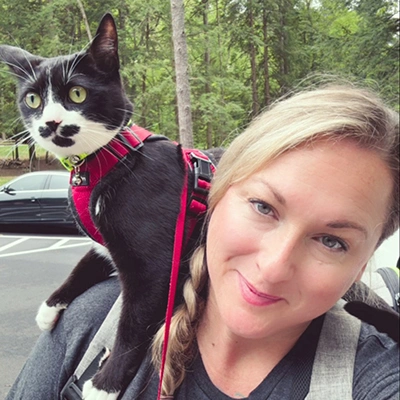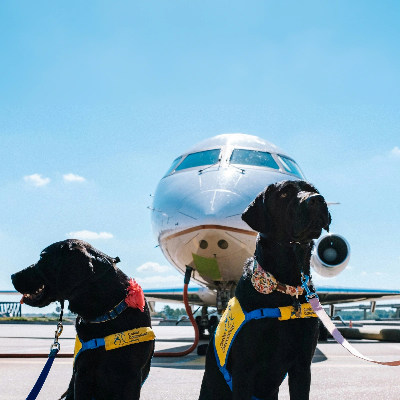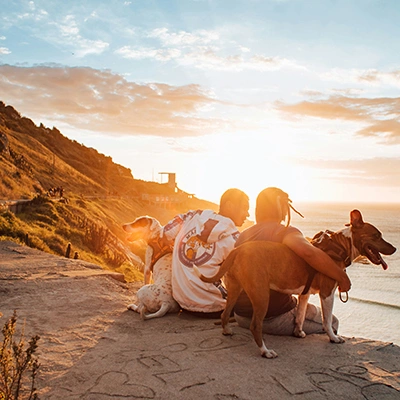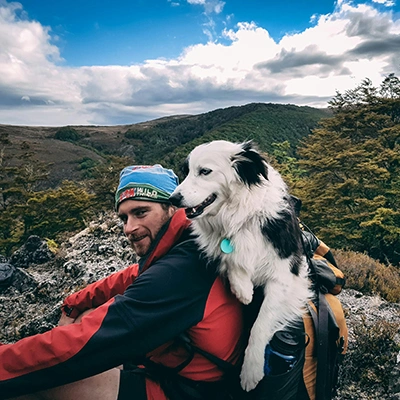Are you one of the 78% of American pet owners who travel with their beloved animals each year?
Traveling with pets can be litters of fun. But it can also be a lot of work if you aren’t prepared for it. Whether you’re planning a road trip or flying across the country, these tips will make it easier — on you and your fur buddy.
Pet Carriers for Travel
Regardless of whether you’re driving or flying during your trip, a pet carrier is a good idea (unless maybe you have a Great Dane, in which case, good luck). We know your pet might not love being crated, but keeping them in a carrier can help keep both of you safe.
If you’re driving, you don’t want an animal climbing on you or creating a distraction. A crate or screen that keeps them in the back of the car — away from the driver — is important.
The crate can also act as a kind of seat belt. If you’re in an accident, your pet will be better protected in a carrier. It can keep them from getting loose in the chaos of an accident and running off.
If you’re flying, the airline will require you to keep your animal in a carrier that fits under the seat.
How to crate train your pet for travel
The sooner you can begin this process, the better. Start with short trips around town where your pet rides in their carrier, providing positive reinforcement as you go. Just like a human child, riding for three straight hours on the first attempt can feel like a lot. But if you start small and build up over time, it will get easier.
A few days before your trip, leave the carrying case out around the house. This gives your pet time to get comfortable with it before hitting the road. Place food inside and let them explore it.
For added comfort, place your pet’s favorite blanket, toy, or treat in the case, too. Some people will even put a worn T-shirt in the crate — something that smells like your pet's favorite human — to put them at ease.
What to Pack when Traveling with Pets
It’s important to bring all the necessary items that your pet uses daily. Your goal is to make them feel like they never left home.
Packing list for pets
- Carrier
- Bedding
- Medicine and veterinary records for that medication
- Vaccination records and health certificates
- Small pet first aid kit
- Toys
- Food, treats, and bowl
- Water and bowl
- Collar, leash, and/or harness
- Waste bags, litter box (and extra litter, scoop), puppy pads
- Cleaning supplies and towels
- Brush/grooming supplies
Flying with Pets
Every airline has its own pet policy for flying with your pet in the cabin, called a carry-on pet. While each of these policies differs, you’ll also see lots of commonalities, regardless of the airline. For example, the pet must be kept in a carrier and stowed under the seat in front of you for the entire flight.
If your pet is too large to fit in a carrier under the seat, some airlines will check your pet in cargo. This can be more stressful for pets, however. Many people choose to drive or leave their pets at home in this situation rather than put the strain of the cargo hold on them.
Cats and small dogs are the most commonly permitted pets on domestic flights, although some airlines also allow household birds and rodents. There are more restrictions if you’re flying internationally and even to Hawaii or Puerto Rico, so check your airline’s rules before you travel.
If you have a puppy or kitten, check with the airline about age restrictions. Some do not allow pets younger than two months old on domestic flights. Others require your pet to be even older.
Expect to show proof of rabies vaccines and other health certification. If your pet does not have current rabies vaccine, you’ll need to update their shots at least 28 days before travel. Even if your airline doesn’t require health certificates, your destination might, so it’s a good idea to have them anyway.
Some airlines have breed restrictions, while others do not. Don’t assume that just because you have a “friendly” breed, you’ll be cleared to fly. Dogs with smooshed faces, like pugs, are often excluded from flying because of respiratory concerns.
Where can I fly with my pet?

Some airlines also have flight time restrictions. For example, American Airlines does not allow pets on flights longer than 12 hours. This is for your pet’s safety and comfort.
While it’s usually advisable to find direct flights whenever possible, you might choose an itinerary with breaks in the middle if you think a single flight will be too long for your pet.
How much does it cost to fly with your dog or cat?
Almost all airlines charge a fee to fly with your pet in the cabin. For Delta, it’s $95 each way for domestic flights. For United Airlines, it’s $125 each way, but if you’re traveling with two pets, you must purchase a second seat in addition to paying the pet fee.
Prices can vary based on your pet’s size, your destination, and whether it’s a carry-on pet or you’re checking them to travel in cargo.
Tell the airline that you’ll be flying with your pet as soon as you book your ticket. Although there’s a fee, there’s still limited space permitted for pets. For example, we’ve seen some airlines restrict it to four pets per plane. Some even restrict it to one animal per cabin, so if another passenger is also flying with their dog, someone’s going to miss out. Make sure you reserve your pet’s spot.
Do pets count as a carry-on item?
Yes. Generally, you can bring your pet in a carrier plus one other item. Depending on the airline, the other item could be either a carry-on bag that meets the requirements of fitting in the overhead bin or a small personal item.
Best airline to travel with pets
Several factors contribute to a company being a “pet-friendly airline” — what kinds of pets are allowed, how many pets you can fly with, the cost of flying with a pet, relief stations and lounge access at airports, and so on. Some of the best airlines for pets include:
- Alaska Airlines
- Delta
- Frontier
Alaska Airlines regularly gets applauded for its flexible pet policy. In addition to cats and dogs, you can fly with your rabbit. You can fly with up to four pets, which is more than most airlines, although once you exceed two, you need to buy an additional seat to accommodate your furry friends. Pets are also permitted in Alaska’s lounges if you have a certain status level with the airline.
If your pet is something other than a cat or dog, you might be in luck with Frontier. The airline allows rabbits, guinea pigs, and hamsters on domestic U.S. flights. Their pet fees are also among some of the lowest at $99 each way. Like many services provided by the budget airline, though, read the fine print of your booking so you aren’t surprised by additional rules or charges.
Road Trips with Pets
Road trips are the easiest way to travel with your pet in some ways. Because you’re driving, you have more control over the pace of the trip, and when and how long you stop to take breaks.
Tips for traveling by car with your pet
- Just like when you slowly introduce your pet to their carrier, take your time getting your pet used to the car. Not all doggos naturally love to go for a R-I-D-E. Let them sit in the car without going anywhere, then gradually go for longer and longer rides until they can travel more comfortably.
- If you don’t want to crate your pet but still don’t want them roaming around the car, try a pet seat belt or a barrier to keep them contained in the back of the car.
- Until you know how your pet’s stomach reacts on car trips, limit how much you feed them during the ride. You still want to make sure they have enough water, though, so they don’t get dehydrated.
- Take plenty of breaks along the route. Let them stretch their legs, burn off some energy, and relieve themselves. While this is mostly a tip for traveling by car with dogs, it also applies to more adventurous cats.
- Don’t leave your pet alone in a car, especially in the summer. When I road tripped with my lab, we ate at drive-ins and had picnics along the way so that he could get out of the car and stay with us during meals.
How to travel with pets in an RV
Many of the same tips and rules you see for road tripping in a car also apply to traveling with your pet in an RV. Keep them in a carrier since your RV doesn’t have seat belts, give them plenty of breaks to stretch and relieve themselves along the way, and bring their own water and food.
When you’re in a motorhome and plan to stay at campgrounds, make sure the campground is pet friendly. Some have breed restrictions and leash laws. As a bonus, look for campgrounds that have dog parks nearby.
You might also look for a campground that offers kennel services or one that’s near a doggy daycare. This will make it easier for you to enjoy day trips and time away from the campground without worrying if your pet is overheating in the RV or upset about being left alone for long periods.
Make sure your pet has shade and clean water at the campground. You might invest in a tent or dog playpen so that they can be outside with and protected from the elements.
Take the height of your RV, motorhome, or camper into consideration, especially if you have a small dog. If they have short legs or aren’t very agile, you might end up constantly lifting them in and out of the vehicle. You could get them some dog-friendly stairs, if necessary.
Taking a Cruise with Pets
With the exception of service dogs, most cruise lines do not allow pets on the ship. In fact, we’ve only been able to find one pet-friendly cruise line: Cunard. Even then, it’s only on select transatlantic itineraries, and the pet must stay in one of the ship’s kennels, not your cabin.
If you do bring an animal on your cruise, know that they may not be able to disembark at ports, especially on international itineraries. Most destinations restrict the entry of animals from other countries, even if they’re service animals.
Pet-Friendly Vacation Rentals
Vacation rentals can be more pet friendly than hotels. For starters, you’re more likely to find a place that has a yard or places to go for walks, which is ideal for traveling with dogs.
Some rental companies like Airbnb do not have pet policies, preferring to let hosts set their own rules. Before you finalize your reservation, contact the host directly to confirm whether your furry friend will truly be welcome.
Are vacation rentals good for pets?
Contact the vacation rental owner directly if the answers to any of these questions are unclear.
- What kind of pet can I bring? Some rentals only allow dogs.
- Are there any breed or size restrictions?
- Is there a pet fee? How much is the deposit?
- What are the rules for having a pet on the property? Do they need to be crated if I’m not home? Do they need to be on a leash at all times outside?
- Does the property have any pet-friendly amenities like a dog bed or food and water bowls (if you don’t want to bring your own)?
- Are there areas of the house where the pet is not allowed?
- If the host doesn’t typically allow pets, ask if there is any room to negotiate during the off-season. They might be willing to bend the rules if there’s less competition for bookings.
Keeping Pets Safe During Travel
Sedating your pet for travel
Talk to your vet before you travel. In most cases, it will be advised to avoid sedating your pet.
If your pet is naturally nervous, ask your vet about a temporary medication for anxiety. You can also spend extra time with them, getting them used to their crate and trying to make them feel more comfortable with good training.
Planning for emergencies
Emergencies can unfortunately happen anytime, anywhere. Before you leave home, plan how you’ll handle them. Your safety plan should include the following:
- Contact Information: Both your own contact information and your veterinarian’s address and phone number are important in case of emergency. Include an emergency contact as well in case you’re in an accident and someone needs to collect your pet while you recover.
- Care: Write a list of the different aspects of your pet’s needs. Include vaccinations, medication routines, feeding habits, and anything else that could be of use.
- Additional Info: In case your pet needs a new place to stay, find a facility for them, both at your destination and back at home.
Updating pet ID records
Some places may require your pet to have a collar and up-to-date tags, even if that’s not the rule where you live. Regardless, make sure all external tags are visible and current. This can help you be reunited with your pet if you get separated for some reason during your trip.
Get your pet microchipped, too. If they already have a chip, make sure their account information and photo are accurate. All too often, we forget to change our address when we move or update our phone number with the chip service.
That’s how I ended up adopting my cat. He was found as a stray, but because his chip wasn’t accurately registered, the shelter couldn’t find his family. Don’t let an administrative lapse keep you apart.
Keeping them hydrated
Humans and animals alike can become dehydrated, especially when in the dry air of a plane. Give your pet water frequently. If they’re stowed away, water them immediately upon arrival.
While driving and on buses and trains, you might not always have easy access to water. Bring your own bottle and a small bowl — or a foldable water bottle dogs can drink from — to keep everyone happy and healthy.
Traveling with Service Animals
Service animals are typically handled differently by airlines, cruise lines, and other travel providers than pets. For example, Delta allows service animals to fly in the plane cabin for free “for qualified individuals with a disability” and doesn’t have to be in a carrier or under the seat. The animal must be a dog. Also, the airline does not recognize emotional support animals as service animals.
If you’re flying with your dog for medical reasons or bringing them on a cruise, check about forms and other requirements such as a harness identifying the dog as a service animal.
You’ll also want to verify requirements at your destination, especially if you’re traveling internationally. Your service animal may not be allowed to enter the country at all — as blind content creator/model/author Molly Burke encountered when traveling to London — or they might need to quarantine upon arrival.
Service animals are generally accepted at attractions such as museums as well as most hotels and vacation rentals. If you have any concerns about whether your animal can accompany you, confirm permission ahead of time.
Travel Insurance for Vacationing with Pets
You’re a responsible pet owner. Be a responsible traveler, too, by purchasing travel insurance. Whether you’re staying in your home country or going overseas, travel insurance can help you protect your money, belongings, and health.
Get a quick quote online or talk to a licensed Seven Corners agent to find the right plan for your next adventure.
Travel Like a Pro with The Wayfinder
Did you enjoy this blog? Get more articles like it before anyone else when you subscribe to our monthly newsletter, The Wayfinder.
Sign me up




